Invisible places
—
This photo essay emerged out of my time as a street outreach worker in London, Ontario. As my coworkers and I traveled through the margins of Canadian society, and spent time with the people who inhabited those margins, we confronted profound social suffering – evidence of the massive inequality that exists within Canada’s ‘universal’ public health care system. I was witnessing historic levels of chronic poverty that, as a social services worker and a photographer, I felt I had to document.
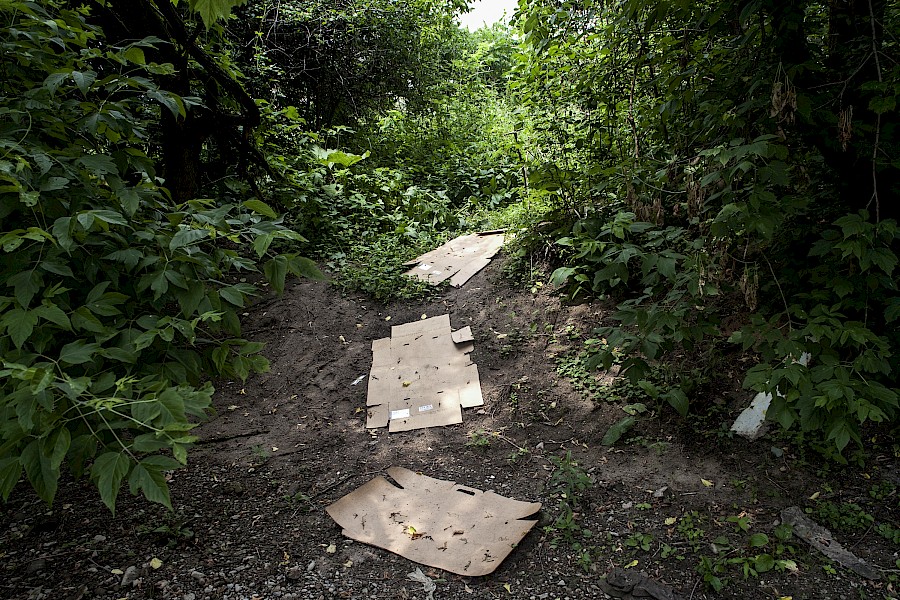 1. Cardboard staircase entrance to site containing cardboard bed, injection drug use gear, and riverfront lawn chair, south of downtown, June 2014
1. Cardboard staircase entrance to site containing cardboard bed, injection drug use gear, and riverfront lawn chair, south of downtown, June 2014As outreach workers funded and managed by the city, our mandate was to support the homeless, mentally ill, and severely addicted. Many of the individuals we served could be found in the downtown core, but many more dwelled in remote forested areas along the banks of the Thames River, just outside the city center. The emergence of these kinds of invisible places is linked to the gradual decline of London’s industrial economy over the past two decades, which has resulted in high rates of unemployment, poverty, and illicit drug use.
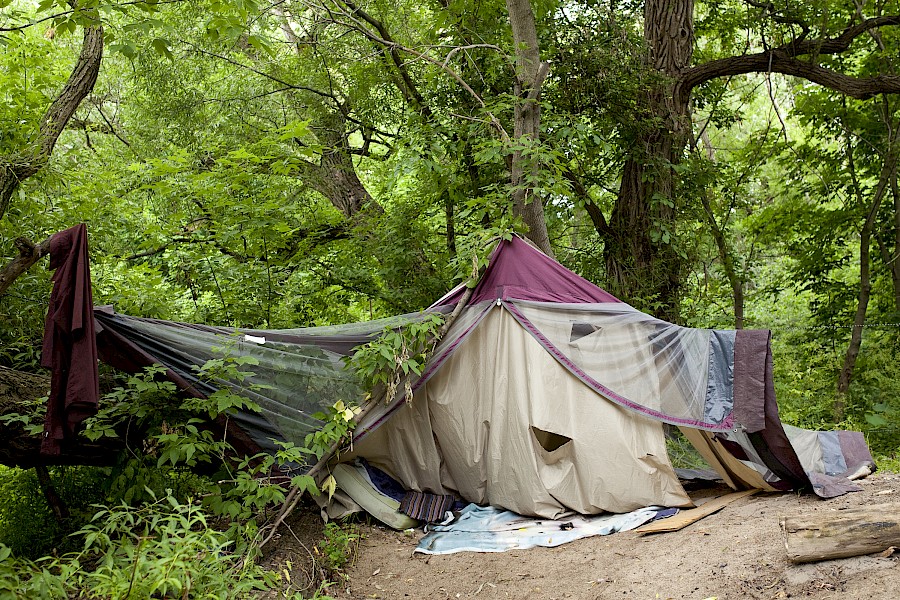 2. Tent structure hung from trees without poles, adjacent to South Street hospital decommission site, June 2014
2. Tent structure hung from trees without poles, adjacent to South Street hospital decommission site, June 2014Our team was responsible for providing people with harm-reduction supplies like clean syringes and alcohol swabs, as well as basic wound care kits. We also regularly supported people in various states of mental and physical crisis, helping them to access services, shelter, and more permanent housing. However, for many of those we were trying to help, finding a shelter or social housing was not a viable option. Faith-based shelters almost always require abstinence from substance use, making it challenging for those with severe addictions to stay there for extended periods of time. And, despite a commitment from the city to reduce homelessness via a ‘housing first’ model that prioritizes low-barrier social housing, waiting lists are notoriously long. Barriers to nonsubsidized, private, market-based housing include a lack of credit and references, as well as a grossly inadequate welfare shelter allowance (CAD $376 per month as of November 2015). When there are no family members or friends who can offer a couch to sleep on, living outdoors during Ontario’s warmer months becomes the only option for many.
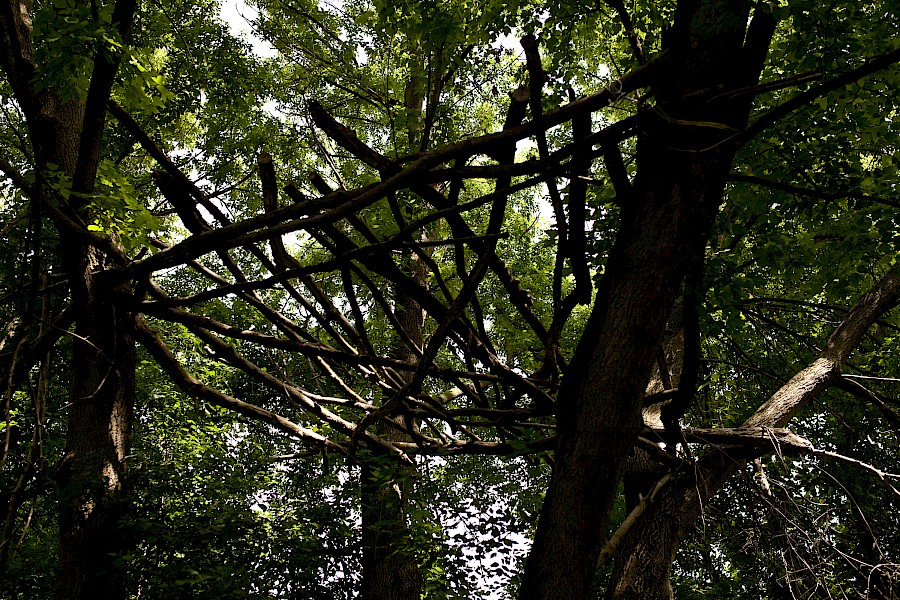 3. Tree-fort structure composed of branches, rope, and string, located between bike trail and riverfront, East London, June 2014
3. Tree-fort structure composed of branches, rope, and string, located between bike trail and riverfront, East London, June 2014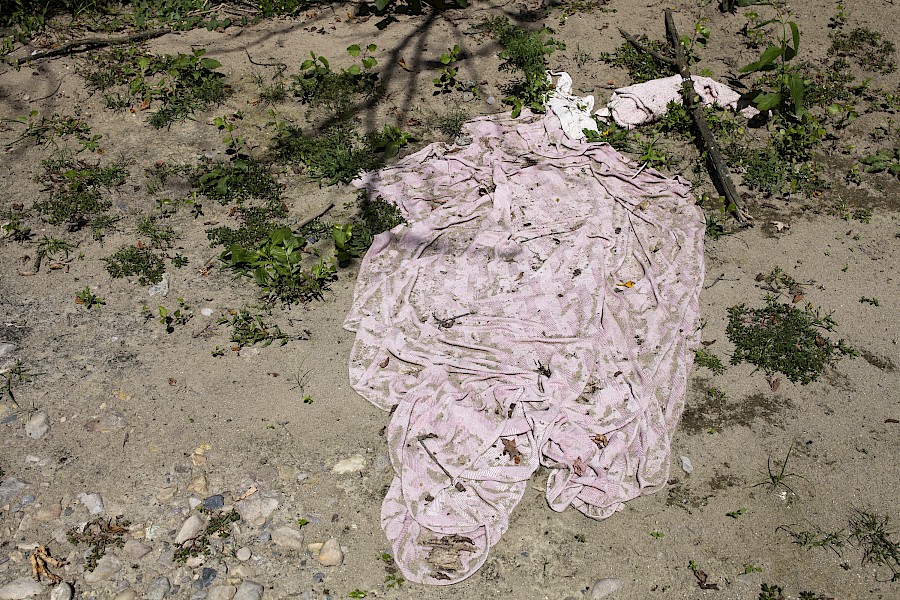 5.Blanket and towel used for bedding, westward along riverfront, a few minutes walk from the downtown core, August 2014
5.Blanket and towel used for bedding, westward along riverfront, a few minutes walk from the downtown core, August 2014While on shift, we spent hours walking under bridges and through overgrown trails. I came to know many homeless individuals and the places they inhabited along the Thames River well. Campsites with half-burned beer cases were common, but we also came across more domestic spaces furnished with clotheslines, chairs for lounging, and makeshift staircases. Stripped wire and other materials traded in the informal economy were also present, evidence of the kinds of labor that are necessary for survival.
The camps were often a testament to people’s abilities to create ‘home’ in the margins. At the same time, the discarded containers of mouthwash (consumed by alcoholics unable to afford liquor), mud-caked syringes, and other ephemera of substance use scattered around these habitations were a stark reminder of the inadequacy of these dwellings. The debris that littered these sites spoke to the need for indoor spaces in which individuals could create more permanent homes and engage in substance use more safely. In addition to shortages in social housing, London has yet to establish a safer injection site or alcohol maintenance program, which would drastically improve the health outcomes of many homeless individuals.
 6. Refuse from encampment containing couch, coffee table, and boards hung from trees and used for a clothing line, East London, August 2014
6. Refuse from encampment containing couch, coffee table, and boards hung from trees and used for a clothing line, East London, August 2014In the spring of 2014, I came across several abandoned sites that people had built during the previous summer, which had since been crushed by snowdrifts or spring floods. These wrecked camps underscored the fragility and impermanence of these places, and were evidence of the profound structural inequality in Canadian society. I set out to photograph these abandoned sites during my time off.
As my survey of vacated sites along the Thames expanded, I weighed the ethics of this kind of documentation. By documenting the spaces and structures that people had left behind, rather than the faces or bodies of people themselves, I was able to avoid reproducing some of the most familiar and clichéd images of urban poverty and tropes of objectification. I refrained from documenting the sites currently inhabited by the people I supported through outreach work, and did not involve them in this side project. As a result, I only ever encountered one person at a site.
Richard was an elderly man who struggled with mental illness and addiction issues, and I had helped him access temporary housing two years earlier. He sat on two railway ties in the sun with a drink in hand while I explained my endeavor. Richard told me he didn’t want to be photographed, nor did I wish to. He didn’t dissuade me from pursuing the project of documenting abandoned sites for the purpose of public education and activism, but he doubted that any action on the part of the city would result. Housing isn’t built unless some profit can be ensured, he told me. Besides, he wanted the city to let him live as he pleased. Like many of the people to whom my coworkers and I had provided support, it was important to Richard to assert his agency and autonomy in spite of structural inequality.
For people like Richard, these sandy, shaded riverfront sites and the structures people built on them provided an important respite from the everyday violence of street life. Largely hidden from public view, they were urban sanctuaries in which individuals could rest, eat, work, organize their belongings, socialize, do drugs, and drink, all in relative privacy. As I discovered more and more vacant sites along the Thames, I chose not to share these locations with other members of the outreach team, out of respect for people’s privacy, should they return. I also increasingly found myself questioning whether our efforts to encourage people to leave their outdoor camps and enter the shelter system were truly helping them. The year before, initiated by citizens’ complaints to the city, I had participated in encouraging a middle-aged man to leave his camp in a forested public park, and to seek shelter or housing elsewhere in the city. He was reluctant to leave. My coworker and I told him that park staff would take down his camp soon and, if nothing else, he might want to move to a more hidden location. He scoffed at our efforts to engage him, and told us plainly that we were making his life more difficult. I believed him.
 7. Riverfront cave structure under abandoned building foundation, appropriated for shelter and injection drug use, East London, August 2014
7. Riverfront cave structure under abandoned building foundation, appropriated for shelter and injection drug use, East London, August 2014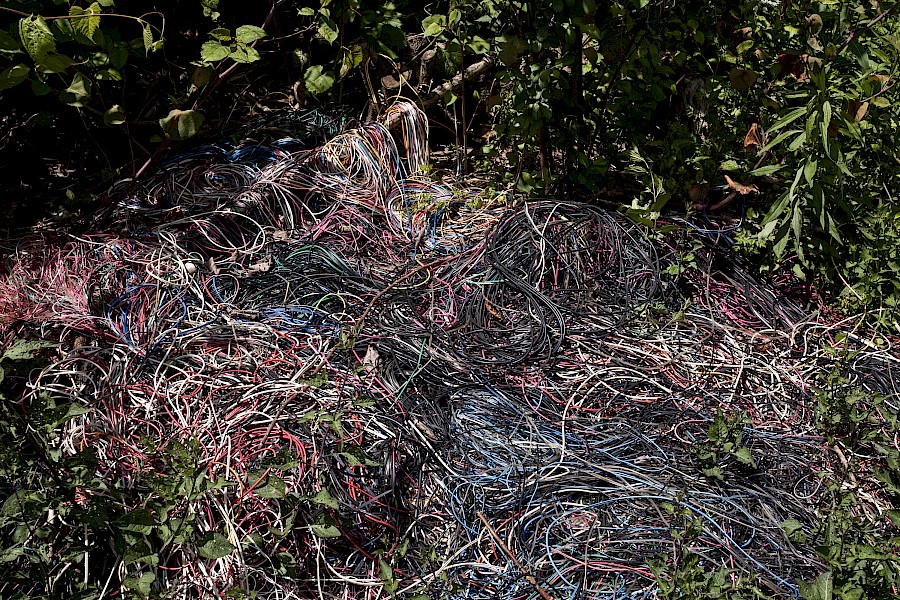 8. Piles of wire casings stripped for metal recycling adjacent to riverfront habitations in East London, June 2015
8. Piles of wire casings stripped for metal recycling adjacent to riverfront habitations in East London, June 2015 9. Clothing hung on tree branches behind baseball stadium, adjacent to riverfront bike path, February 2014
9. Clothing hung on tree branches behind baseball stadium, adjacent to riverfront bike path, February 2014Late in 2014, I left outreach work. The stress and trauma of supporting people through crisis after crisis had become unsustainable for me. I continued to photograph river sites until the summer of 2015. These photographs had become a way of bearing witness (Farmer 2011) to poverty, inequality, and the ingenuity required to survive. They were also a way of educating and informing the public through exhibition and publication. Still, I felt that I had only just begun to comprehend the dynamics of marginalization and autonomy motivating people to live on the Thames.
 10. Discarded beer cases surrounded by animal tracks in the snow lay on top of the frozen river near the Wortley Village neighborhood near downtown London, February 2015
10. Discarded beer cases surrounded by animal tracks in the snow lay on top of the frozen river near the Wortley Village neighborhood near downtown London, February 2015About the author
Justin Langille is a master’s degree candidate in anthropology at Carleton University in Ottawa, Ontario, Canada. He holds an undergraduate degree in anthropology and a diploma in journalism. His documentary photography has been featured by Vancouver’s Capture Photography Festival, The Walrus, MaisonneuveMagazine, and Boreal Collective.
Reference
Farmer, Paul. 2011. Haiti: After the Earthquake. Pittsburgh, PA: University of Pittsburgh Press.
